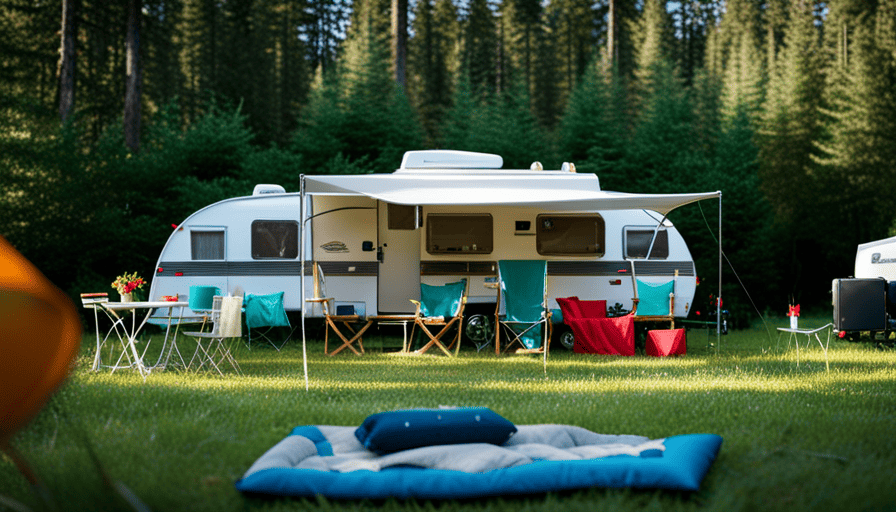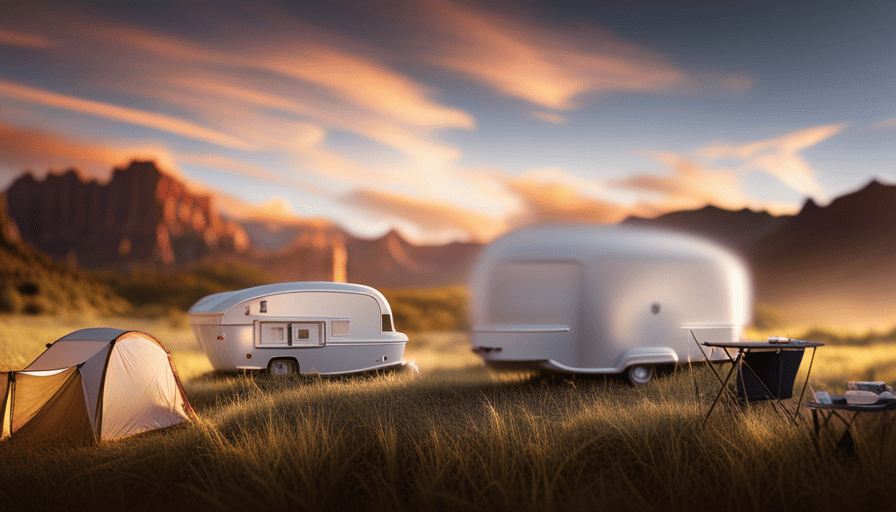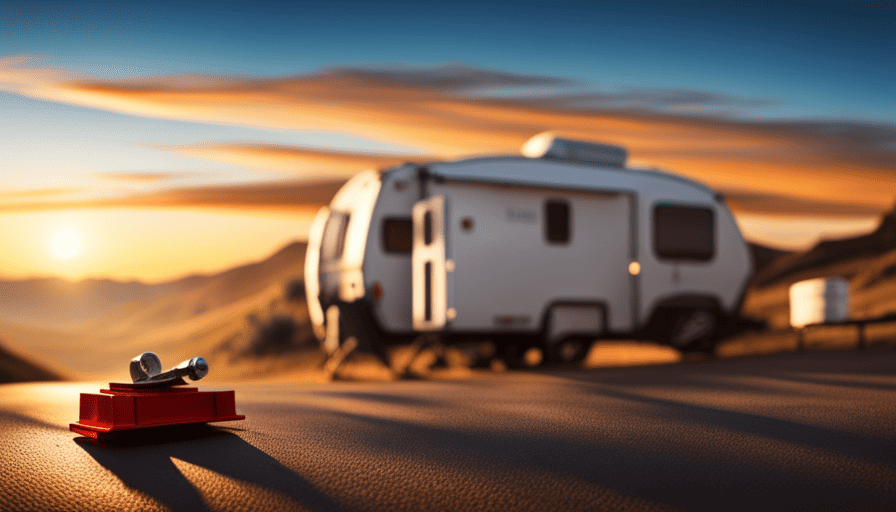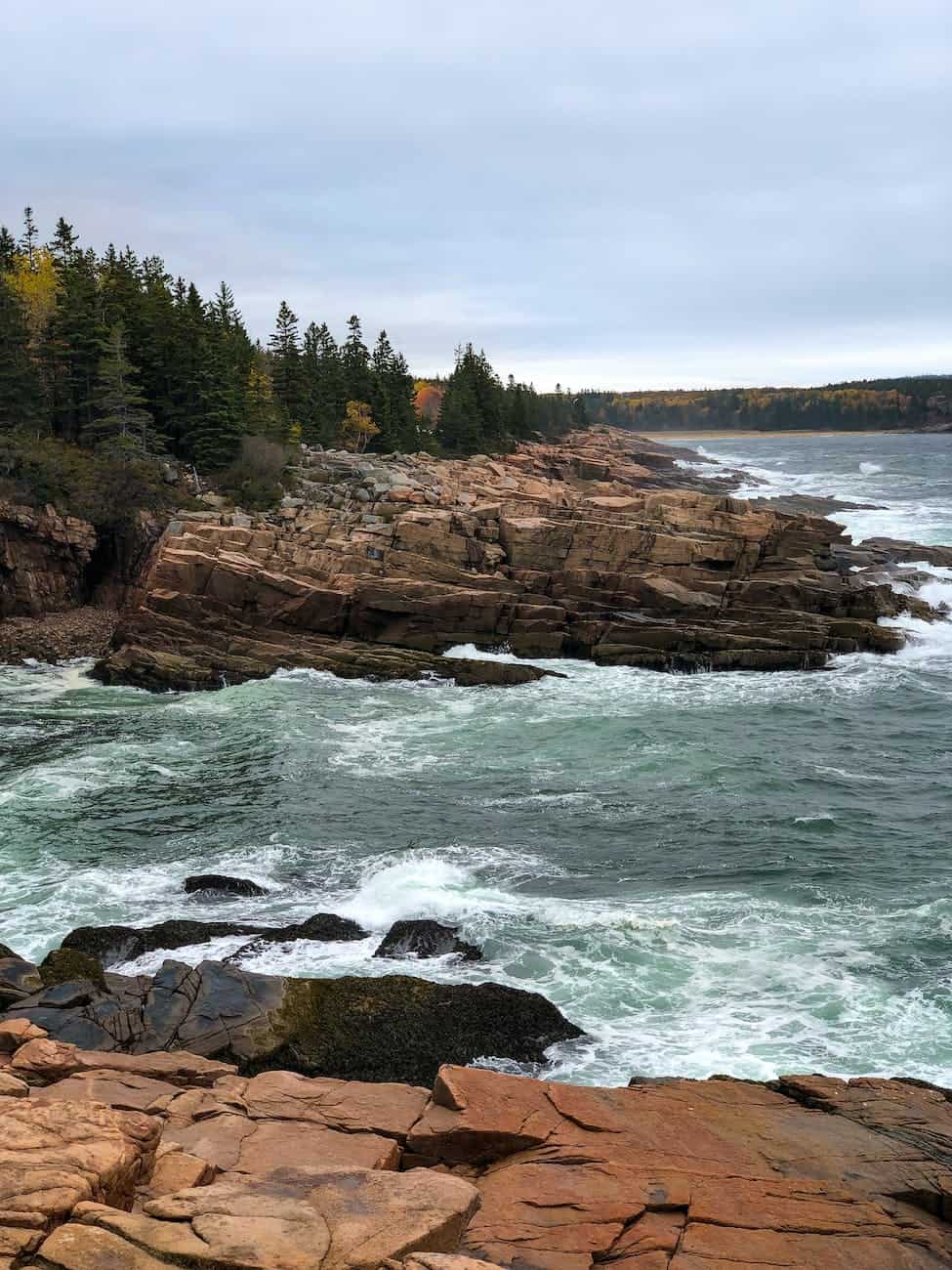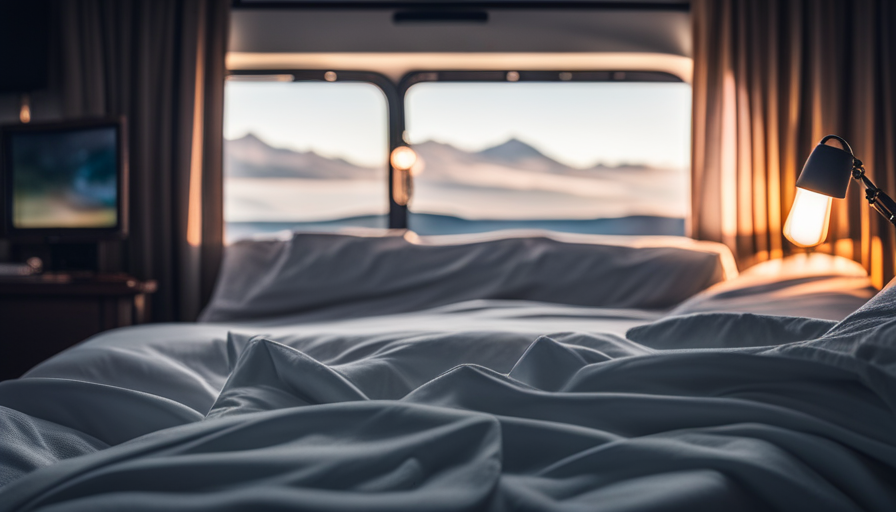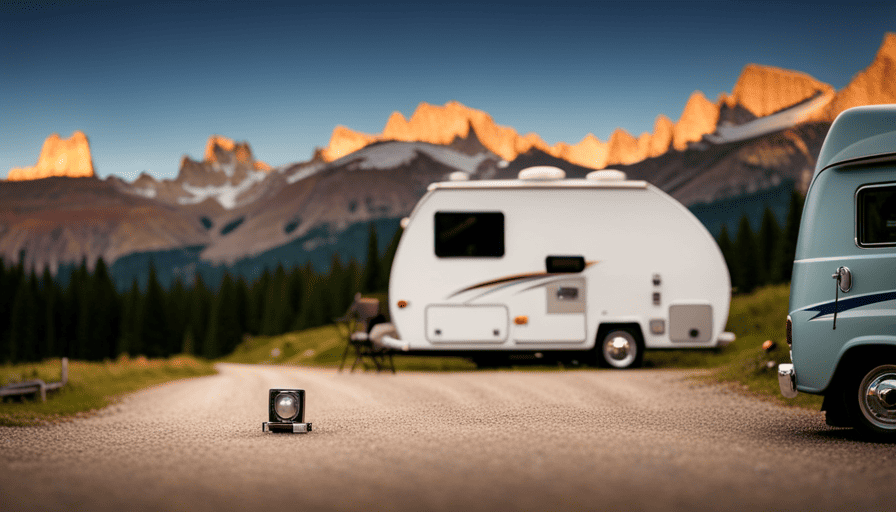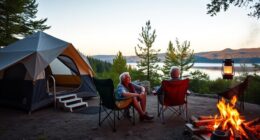Are you interested in the size of a pop-up camper? Well, they come in a range of shapes and sizes! Whether you want a small, easy-to-tow option or a larger camper for the whole family, there’s definitely a pop-up camper to suit your needs.
When I first started camping, I was amazed at the variety of pop up campers available. They range in size from small, cozy trailers to large, roomy ones that feel like a home away from home. The dimensions of a pop up camper can vary greatly, but on average, they are around 10 to 20 feet long and 6 to 8 feet wide when fully set up.
One of the great things about pop up campers is that they are easy to tow and set up. With just a few simple steps, you can have your camper ready to go in no time. Plus, they offer a comfortable sleeping space for anywhere from 2 to 8 people, depending on the size of the camper.
In this article, I’ll give you all the details on the different types of pop up campers, their dimensions, sleeping capacity, setup process, towing requirements, and even cost considerations. So, if you’re in the market for a pop up camper or simply curious about their size, keep reading to find the perfect fit for your camping adventures.
Key Takeaways
- Pop up campers come in various sizes, ranging from 10-20 feet long and 6-8 feet wide when fully set up.
- They provide sleeping area, kitchenette, and dining space, accommodating 2-8 people comfortably.
- Pop up campers are ideal for small families or couples, offering a compact and hassle-free camping experience.
- The size of the pop-up camper should meet specific needs and preferences, considering factors such as weight capacity, off-road capabilities, and the amount of gear to be carried.
Types of Pop Up Campers
Are you curious about the various types of pop up campers and their sizes? Well, let me share my experience and knowledge about this topic.
Pop up campers come in a variety of sizes and styles, each with its own unique features. Some popular pop up camper brands include Jayco, Forest River, and Coachmen.
One type of pop up camper is called a tent trailer. These campers have canvas sides that can be raised and lowered, allowing for easy setup and breakdown. They’re lightweight and compact, making them perfect for smaller vehicles or those who prefer a more minimalist camping experience.
Another type is the A-frame camper, which is known for its triangular shape when set up. It offers more interior space and often includes amenities such as a kitchenette and bathroom.
Now, let’s transition into discussing the average dimensions of pop up campers. These campers typically range in length from 8 to 18 feet, with the average being around 12 to 14 feet. They’re usually 6 to 7 feet wide when fully expanded. Keep in mind that these dimensions can vary depending on the specific model and brand.
So, whether you’re looking for a compact tent trailer or a spacious A-frame camper, there’s a pop up camper out there that’ll suit your needs.
Average Dimensions of Pop Up Campers
Most people would never guess the sheer size of these compact, collapsible abodes on wheels. Pop up campers may appear small from the outside, but once expanded, they provide a surprising amount of space for their owners to enjoy.
The average dimensions of a pop up camper when fully extended are around 20 feet in length and 7 to 8 feet in width. This allows for a comfortable sleeping area, a small kitchenette, and even a dining space.
When it comes to compact vs. traditional pop up campers, the main difference lies in their size and weight. Compact pop up campers are designed to be smaller and lighter, making them easier to tow and maneuver. They’re perfect for those who prioritize mobility and prefer a more minimalist camping experience.
On the other hand, traditional pop up campers offer more space and amenities, making them suitable for larger families or those who enjoy a bit more comfort while camping.
One of the great things about pop up campers is the customization options available. Owners can choose from a variety of floor plans, interior finishes, and add-on features to personalize their camping experience. From extra storage compartments to built-in bathrooms, the possibilities are endless.
In the next section, we’ll explore the benefits of compact and lightweight pop up campers, highlighting their advantages for outdoor enthusiasts on the go.
Compact and Lightweight Pop Up Campers
When it comes to pop up campers, compact models offer numerous benefits. They’re easy to tow and maneuver, making them perfect for those who are new to camping or prefer a smaller setup.
The lightweight design also means you can save on gas mileage and have more flexibility when it comes to choosing a campsite. These compact models are ideal for small families or couples who want a cozy and comfortable camping experience without the hassle of a larger RV.
Benefits of Compact Models
One of the advantages of choosing a compact pop-up camper is that you’ll have the convenience and maneuverability to access remote campsites that larger models may struggle with. Compact pop-up campers are designed with portability in mind, making them easy to tow and navigate through tight spaces.
Their compact size allows them to fit into smaller campsites, giving you more options when choosing a campsite. Additionally, compact pop-up campers are lighter in weight, making them easier to tow and requiring less fuel consumption. This means you can go further on your camping adventures without worrying about the size and weight of your camper.
When considering weight, it’s important to find a balance between a lightweight camper and the amenities and features you desire.
Weight Considerations
Towing a compact pop-up camper is like pulling a feather, allowing you to effortlessly navigate through tight spaces and access remote campsites. Here are four reasons why weight considerations are crucial for a portable pop-up camper:
-
Lightweight design: Compact pop-up campers are specifically designed to be lightweight, making them easy to tow with smaller vehicles.
-
Maneuverability: The reduced weight of a compact pop-up camper enhances its maneuverability, allowing for smooth turns and easy navigation on narrow roads.
-
Fuel efficiency: With a lighter weight, towing a compact pop-up camper won’t put a strain on your vehicle’s fuel consumption, saving you money at the pump.
-
Payload capacity: Despite their size, compact pop-up campers still offer ample storage space for your camping gear, ensuring you can bring along everything you need for your adventure.
Considering their portability and payload capacity, compact pop-up campers are ideal for small families or couples looking to explore the great outdoors.
Ideal for Small Families or Couples
For small families or couples, a portable pop-up camper is the perfect gateway to unforgettable adventures in the great outdoors. These compact options provide all the necessary amenities while still being easy to tow and maneuver.
From cozy sleeping quarters to a compact kitchenette, these campers are designed to maximize space without sacrificing comfort. Maintenance and upkeep are relatively simple, and with regular care, these campers can last for many years.
Whether you opt for a more basic model or a luxury option with additional features, pop-up campers offer a hassle-free camping experience. With their lightweight design and compact size, they’re easy to store and transport, making them a popular choice for those who want to explore the great outdoors without the need for a large RV.
Transitioning into the next section, let’s now discuss the benefits of spacious pop-up campers.
Spacious Pop Up Campers
With a spacious interior that can comfortably sleep up to six people, pop up campers are the perfect choice for families looking to embark on unforgettable outdoor adventures. These campers may appear compact from the outside, but once you step inside, you’ll be amazed by the amount of space they offer.
The spacious interior allows for a comfortable living area where everyone can gather, play games, or simply relax after a long day of exploring the great outdoors. One of the reasons why pop up campers feel so roomy is because of the clever use of space-saving features and amenities available. You’ll find that these campers are equipped with well-designed storage compartments, folding furniture, and versatile layouts that maximize every inch of available space. From a fully functional kitchenette with a stove and sink to a cozy dinette that easily converts into an additional sleeping area, pop up campers offer all the comforts of home in a compact package.
Moving on to the next section about the sleeping capacity of pop up campers, it’s worth noting that these campers are not only spacious in terms of living areas but also when it comes to sleeping arrangements. So, let’s dive into the various sleeping options that pop up campers provide for a good night’s rest.
Sleeping Capacity of Pop Up Campers
Step inside and discover the surprising number of sleeping options available in these spacious campers, ensuring you and your family a restful night’s sleep. Pop up campers may be compact in size, but they can still offer comfortable sleeping arrangements for your camping adventures.
Depending on the model, these campers can accommodate anywhere from two to eight people. The sleeping capacity is usually determined by the number of beds or sleeping areas available, which can include fold-out beds, bunk beds, and dinette conversions.
One of the pros of pop up camper sleeping capacity is the versatility it provides. With multiple sleeping options, you can customize the arrangement to suit your needs. For instance, if you’re camping with kids, bunk beds can be a fun and space-saving solution. On the other hand, if you prefer more privacy, some models offer separate sleeping areas.
However, there are a few cons to consider as well. The sleeping areas in pop up campers are generally smaller than in larger RVs or motorhomes. This means that taller individuals may find it uncomfortable to sleep in them. Additionally, the beds may not be as plush or supportive as those in traditional mattresses, which could affect the quality of your sleep.
Transitioning into the subsequent section about storage space in pop up campers, you’ll find that maximizing storage is essential when you have limited space for your camping gear and personal belongings.
Storage Space in Pop Up Campers
When it comes to storing your camping gear and personal belongings, a pop-up camper is like a treasure chest with hidden compartments waiting to be discovered. The storage organization in a pop-up camper is designed to maximize space and make the most of every nook and cranny.
From the moment you step inside, you’ll find cleverly designed cabinets, shelves, and drawers strategically placed throughout the camper. These storage spaces are perfect for keeping your clothes, cooking utensils, and other essentials organized and easily accessible.
One of the key features of pop-up campers is their ability to provide ample storage without sacrificing living space. The cabinets and shelves are strategically placed to make the best use of available space. Additionally, many pop-up campers have under-seat storage compartments, allowing you to store larger items such as camping chairs or coolers. Some models even have overhead storage compartments, perfect for storing lighter items like bedding or clothing.
Maximizing space in a pop-up camper is all about efficient organization. Utilize storage containers and organizers to keep smaller items in place and prevent them from shifting during travel. Use collapsible storage bins to make the most of every inch of available space. By carefully planning and organizing your belongings, you can ensure that everything has its place and that you can easily find what you need when you need it.
Transitioning into the subsequent section about the setup and takedown process, it’s important to note that a well-organized storage system can greatly streamline the overall camping experience.
Setup and Takedown Process
To make your camping experience more enjoyable, you’ll want to know the setup and takedown process of your portable camper. Setting up and taking down a pop-up camper can seem daunting at first, but with a little practice, it becomes a breeze. Here are some tips to help you navigate the setup and takedown process:
-
Start by finding a level and clear area to set up your camper. This will make the process easier and ensure your camper is stable.
-
Begin by unfolding the camper and extending the stabilizer jacks. This will provide a solid foundation for your camper.
-
Next, raise the roof and secure it in place. Make sure all latches and locks are properly engaged to ensure safety.
-
Finally, connect the necessary utilities such as water and electricity, and finish by setting up your camping gear inside.
When it’s time to take down your camper, follow these steps in reverse order. Remember to secure all latches, close all windows and doors, and retract the stabilizer jacks. With practice, the setup and takedown process will become second nature.
Now that you know the setup and takedown process, let’s move on to the next important aspect of pop-up camping: towing requirements.
Towing Requirements
When it comes to towing a pop-up camper, there are a few important things to consider. First and foremost is your vehicle’s towing capacity. It’s crucial to know how much weight your vehicle can safely tow before hitting the road with your pop-up camper in tow. Exceeding your vehicle’s towing capacity can lead to dangerous situations and potential damage to your vehicle.
In addition to towing capacity, there are also safety concerns to keep in mind. It’s essential to properly distribute the weight of your pop-up camper to ensure stability while driving. This means loading heavier items towards the front and keeping the center of gravity low. Additionally, be aware of any height restrictions on the roads you plan to travel on, as pop-up campers can be taller than regular vehicles.
Considering these towing requirements and safety concerns will help ensure a smooth and safe journey with your pop-up camper.
Now, let’s move on to the next important aspect of owning a pop-up camper: cost considerations.
Cost Considerations
When it comes to considering the cost of a pop-up camper, there are a few key points to keep in mind. First and foremost is the price range, which can vary greatly depending on the size and features of the camper.
Additionally, it’s important to factor in any additional expenses such as maintenance, storage, and campground fees.
Lastly, financing and insurance options should also be taken into account, as they can greatly impact the overall cost of owning a pop-up camper.
Price Range
The price range for a pop-up camper can vary widely depending on the features and condition. When considering the cost of a pop-up camper, it’s important to take into account the specific features you’re looking for. Some popular features include a kitchenette, bathroom, air conditioning, and sleeping accommodations for a certain number of people.
In addition, the brand of the pop-up camper can also affect the price range. Popular brands like Jayco, Forest River, and Coachmen may be priced higher due to their reputation for quality and durability. It’s important to compare prices and features across different brands to find the best value for your needs.
Keep in mind that additional expenses such as insurance, maintenance, and storage should also be considered when budgeting for a pop-up camper.
Additional Expenses
One potential concern some may have is the added expenses associated with owning a pop-up camper, such as insurance, maintenance, and storage.
When it comes to camping gear, it’s important to factor in the cost of outfitting your camper with the necessary equipment. This may include items like sleeping bags, cooking utensils, and camping chairs. These expenses can add up quickly, especially if you’re starting from scratch.
Additionally, maintaining a pop-up camper comes with its own costs. Regular maintenance, such as checking the tires, inspecting the roof, and servicing the appliances, is necessary to ensure the camper’s longevity and safety. These maintenance costs should be budgeted for and taken into consideration.
As for storage, if you don’t have enough space on your property, you may need to pay for off-site storage, which can be an added expense.
Transitioning into the subsequent section about financing and insurance options, it’s important to consider these additional costs when budgeting for a pop-up camper.
Financing and Insurance Options
Securing appropriate financing and insurance for your collapsible camping trailer is crucial in order to protect your investment and ensure peace of mind. Here are some financing options and insurance coverage tips that can help you make the right choices for your pop-up camper:
-
Financing Options: Consider getting a loan from a bank or credit union, as they often offer competitive interest rates for recreational vehicles. You can also explore financing options offered by the camper dealership or manufacturer.
-
Insurance Coverage: Look for an insurance policy that covers both liability and physical damage. It’s important to have coverage for accidents, theft, and natural disasters. You may also want to consider adding coverage for personal belongings and roadside assistance.
-
Shop Around: Get quotes from multiple insurance providers and compare coverage options and prices. This will help you find the best insurance policy that suits your needs and budget.
-
Read the Fine Print: Before finalizing any financing or insurance agreements, carefully read the terms and conditions, including any exclusions or limitations.
Securing the right financing and insurance for your pop-up camper is just the first step in the process of choosing the right one for your needs.
Choosing the Right Pop Up Camper
When choosing the right pop-up camper, you’ll want to consider its size to ensure it meets your needs and preferences. One important factor to consider is the weight capacity of the camper. You’ll want to make sure that the camper can comfortably accommodate the weight of your belongings and any additional equipment you may bring along.
It’s also important to consider the off-road capabilities of the camper if you plan on taking it on rugged terrain. Some pop-up campers are specifically designed for off-road adventures and feature reinforced frames, high ground clearance, and rugged tires. These features can make a big difference in how well your camper performs on rough terrain.
Additionally, the size of the pop-up camper will determine how much space you have inside for sleeping, dining, and storage. If you’re planning on traveling with a large group or carrying a lot of gear, you may want to consider a larger size camper. On the other hand, if you’re looking for something more compact and easy to tow, a smaller size camper may be a better fit.
Ultimately, the right pop-up camper size will depend on your specific needs and preferences.
Frequently Asked Questions
What are the most common towing requirements for a pop up camper?
The most common towing requirements for a pop-up camper depend on its weight and size. The towing capacity of your vehicle is crucial, as it determines the maximum weight your vehicle can safely tow.
Additionally, you’ll need a hitch that matches the camper’s weight and type, such as a ball hitch or a weight distribution hitch. It’s important to consult your vehicle’s manual and the camper’s specifications for accurate hitch requirements.
How much does it typically cost to purchase a pop up camper?
When considering the cost of purchasing a pop up camper, there are several factors to take into account. These factors include the brand, model, features, and condition of the camper. Additionally, buying options can vary, such as purchasing new or used, or even renting. It’s important to research and compare prices to find the best deal for your budget. Keep in mind that prices can range from a few thousand dollars to tens of thousands of dollars, depending on the factors mentioned.
What factors should be considered when choosing the right pop up camper?
When choosing the right pop up camper, there are several important factors to consider.
First and foremost, think about your camping style and how you plan to use the camper. Are you a solo traveler or do you have a family?
Second, consider the weight and size of the camper, as well as its towing capacity.
Third, think about the amenities and features that are important to you, such as a kitchenette or bathroom.
Lastly, don’t forget to factor in your budget and maintenance costs.
How long does it usually take to set up and take down a pop up camper?
Setting up a pop-up camper usually takes around 30 minutes, depending on your experience and familiarity with the process. It involves extending the camper’s frame, raising the roof, and securing the various components.
Taking down a pop-up camper requires a similar amount of time, as you need to fold and collapse the different sections, stow away the equipment, and secure everything for travel.
Overall, setting up and taking down a pop-up camper can be done relatively quickly and efficiently.
How much storage space is typically available in a pop up camper?
When it comes to storage space in a pop-up camper, it’s like having a walk-in closet on wheels. Despite its compact size, these campers are designed ingeniously to maximize storage capacity. You’ll find ample cabinets, drawers, and cleverly hidden compartments to stow away all your camping essentials.
The weight capacity varies depending on the model, but most pop-up campers can handle a decent amount of gear without compromising comfort or safety.
What Is the Difference in Size Between a Camper and a Pop Up Camper?
The size of a camper and a pop up camper can vary significantly. A standard camper is typically larger, with more living space and amenities. On the other hand, a pop up camper is compact and lightweight when folded, making it easier to tow. Consider your needs and preferences before choosing the size of a camper that suits your camping adventures.
Conclusion
After my extensive research on pop up campers, I can confidently conclude that they come in various types, sizes, and dimensions.
From compact and lightweight options to spacious ones, there is a pop up camper to suit everyone’s needs.
The setup and takedown process may require some effort, but it’s worth it for the comfort and convenience they provide.
Just like a cozy cocoon that envelops you in warmth, a pop up camper offers a home away from home experience that’ll make your camping adventures unforgettable.

